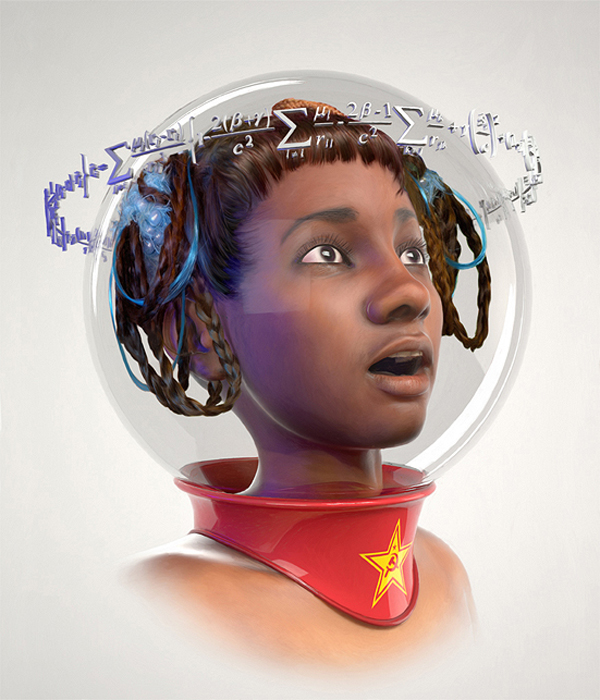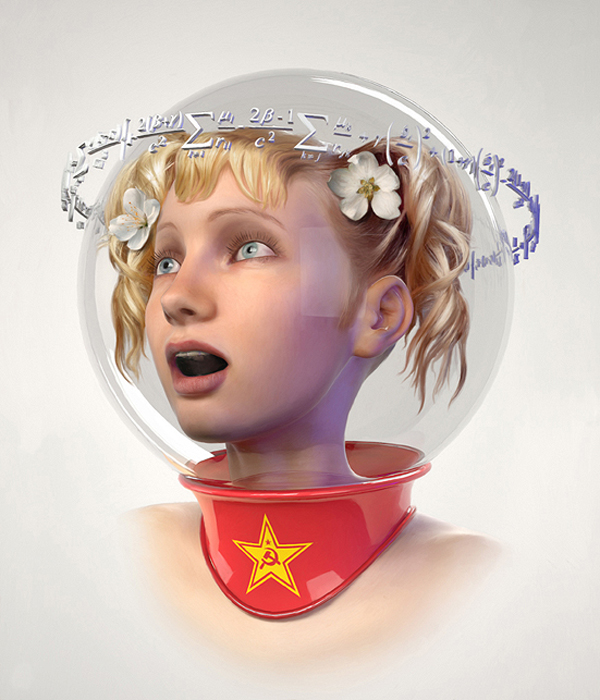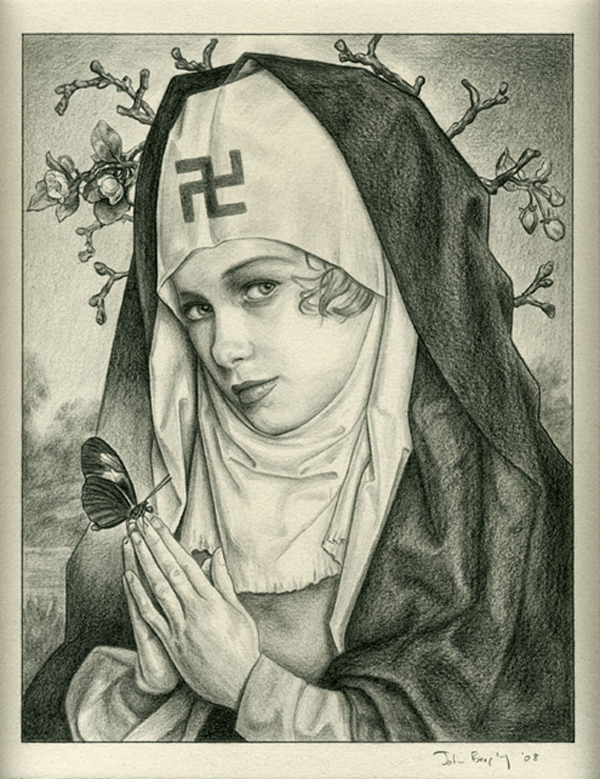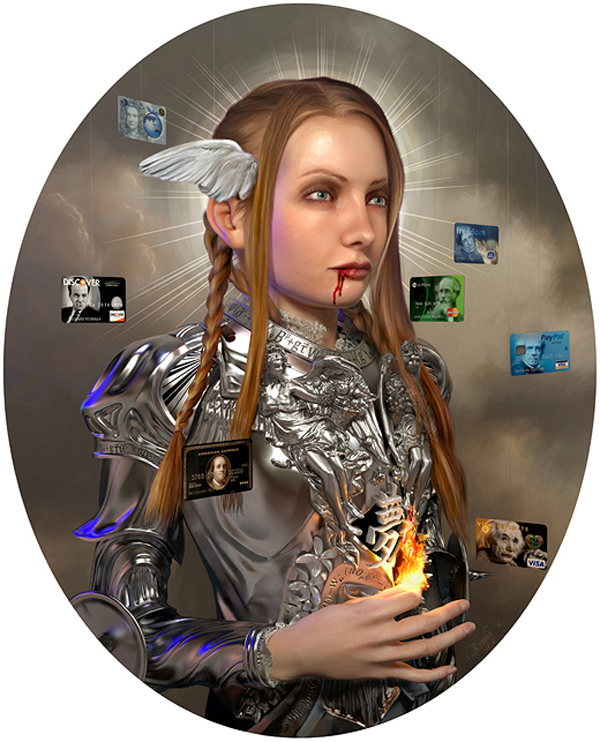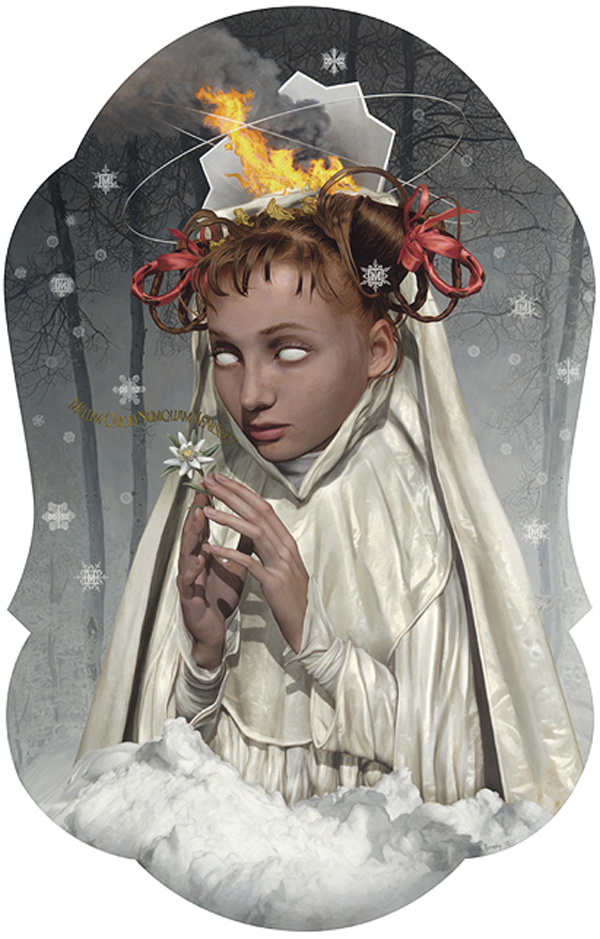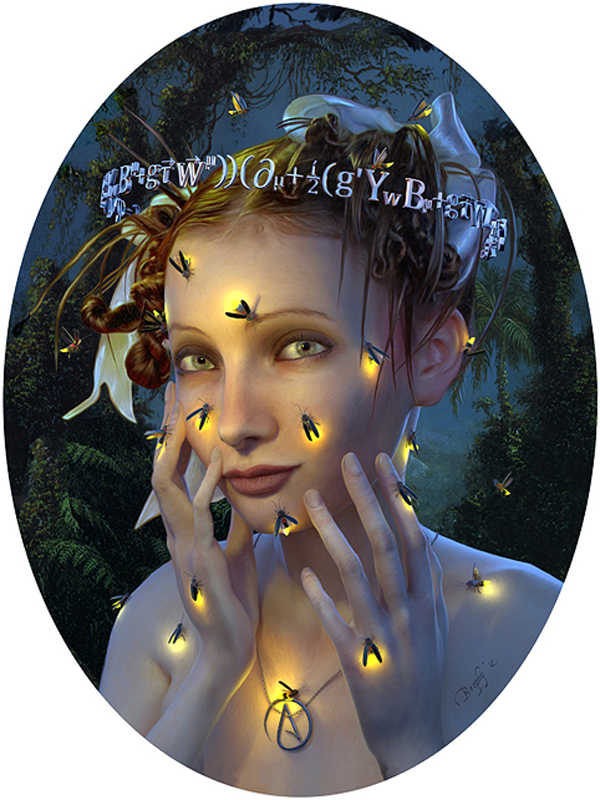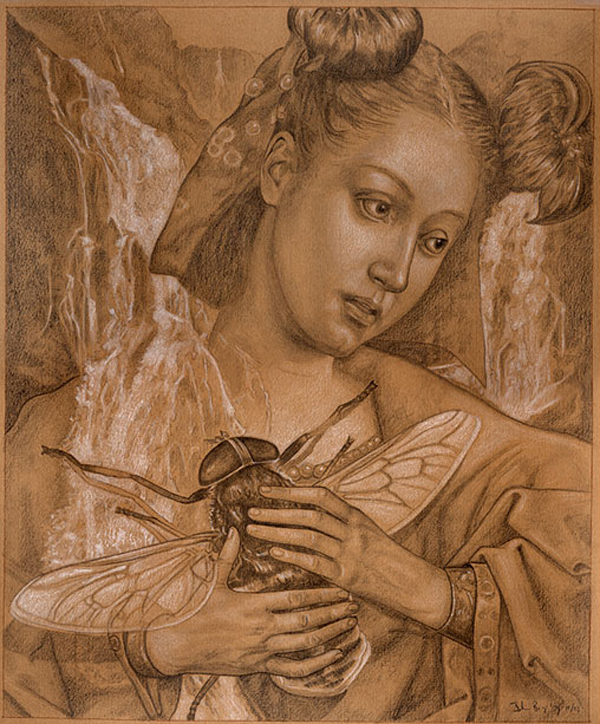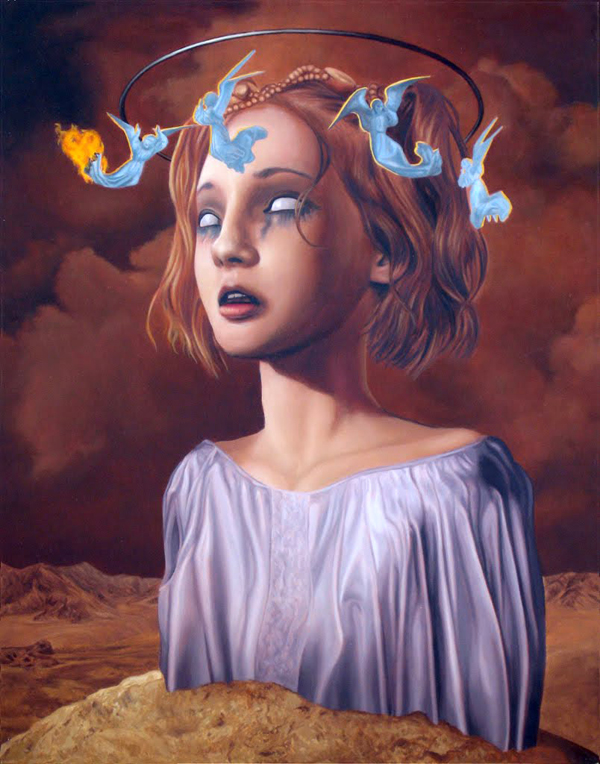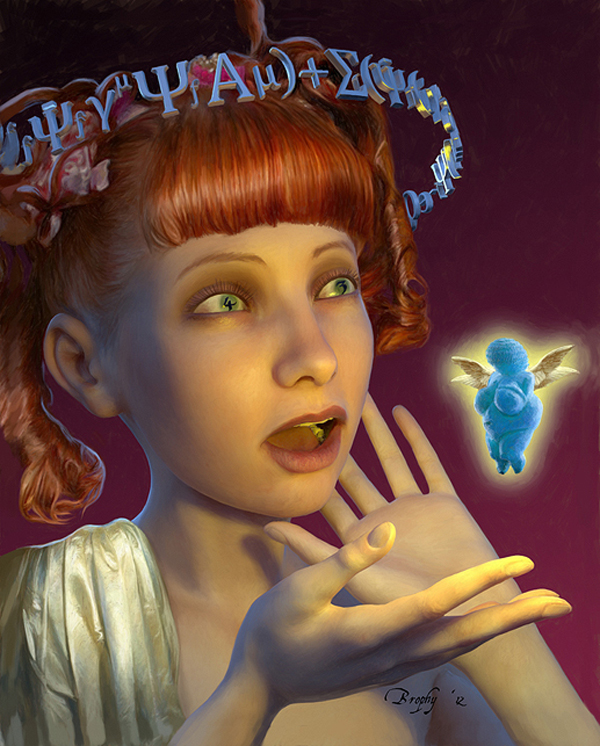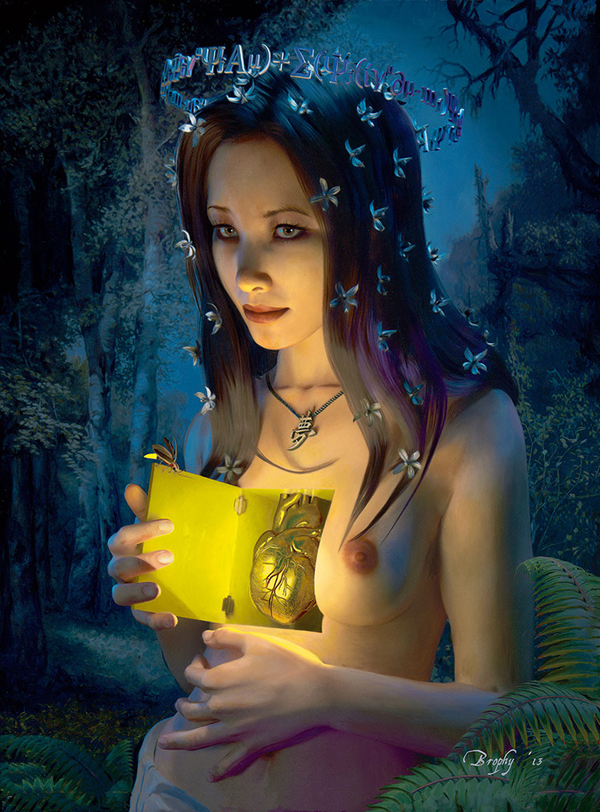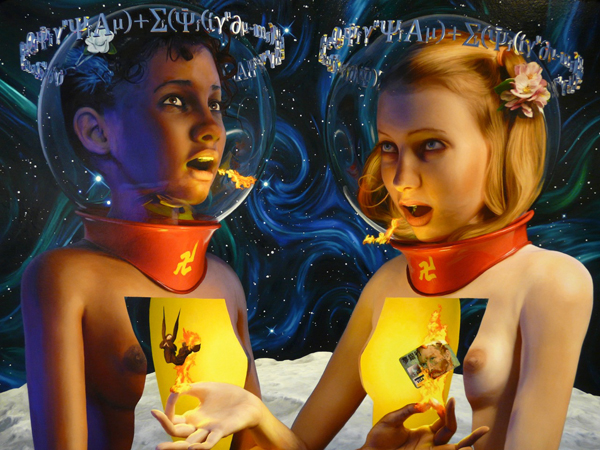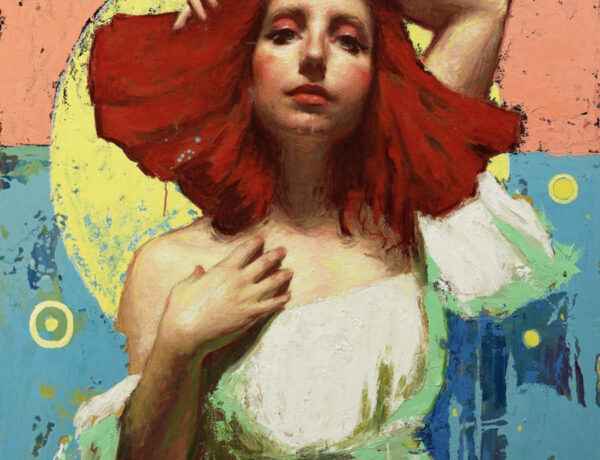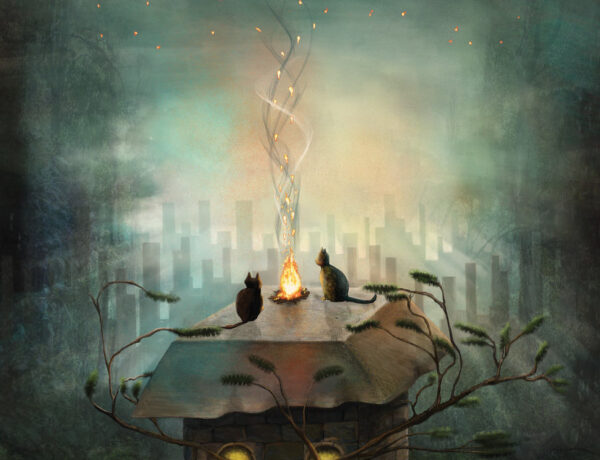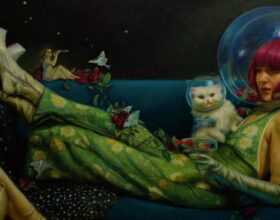Beautiful.bizarre recently got the chance to sit down with Seattle based painter John Brophy to talk about everything from Jesus Bombs to his friendship with Brian Despain and what it was like to have his very first art show at the legendary Roq La Rue Gallery.
You just came off a huge show at Roq La Rue, you are in the December issue of beautiful.bizarre and you are smack in the middle of the rainy season in Seattle. So, how are you and what’s life like? Walking on air, too busy to really notice or hungover from a phenomenal December?
I’m really happy with the work from this last show, but putting it together nearly did me in. The process I use is very time consuming and it’s always a fight to get a reasonable number of pieces finished in time for a show. And for this last one I was up for three days straight before the opening trying to get everything finished, framed, and delivered. In fact, I delivered the last few paintings to the gallery with only 20 minutes to spare before the opening started! Needless to say, the whole evening afterward was a blur. I then had to turn around and finish up another piece for the Juxtapoz show in LA. I guess it never ends. But it really is nice to be in demand!
It’s finally quieted down a bit now and I’ve been using the time to review my process and make some improvements. Also to plan out some large compositions that I want to do next. I have a few large canvases that have been sitting in my studio that are primed and ready to go. And since my wife and I plan to move to Ireland later this year, I want to get these canvases painted. It would be a shame to have put so much effort into making them -prepared the traditional way with lead primer and left to cure for a few years- and then have to put them in storage. I’ve also been doing some tech research into traditional painting materials and learning some new software. At the same time we are slowly getting the house ready to put on the market. But in our down time my wife and I curl up on the sofa with our cat, Butter, and watch “Sons of Anarchy” or “Homeland”, etc until the raccoon family shows up at the back door for a visit. Then we go sit with them outside on our deck and just commune with nature for a while. I know a lot of people would be straight on the phone to someone like raccoon removal Baltimore if this happened to them, but we love our raccoons! There is a mom and three kids, but the kids are nearly full grown now. They come and go, but usually visit a few times a week. Technically, Washington state doesn’t recognize raccoons as pets, but to us they are our extended family. I even made a video of one of their visits and posted it on YouTube. So if you would like to take a trip to Raccoon Town, you can see it here: http://youtu.be/v_LI_HmR5QU
I also read all the time and almost always have a few books going at once. Right now I’m riding a Philip K. Dick wave. I just finished reading “Ubik” (which is very similar in spirit to one of my very favorite books “Hard-Boiled Wonderland and the End of the World” by Haruki Murakami), and now I’m starting “Do Androids Dream of Electric Sheep?” At the same time I’m re-reading “The Demon-Haunted World” by Carl Sagan, and “The Mastery of Oil Painting” by Frederic Taubes.
For music I listen to X, Nick Cave. Stuff like that. But when I’m painting I usually listen to online debates (Matt Dillahunty vs anybody, Lawrence Krauss, Richard Dawkins, Christopher Hitchens, Stephen Fry, etc), podcasts like The Atheist Experience, Frontline, Rachel Maddow, The Infinite Monkey Cage, Bill Maher, etc. But when I listen to music while I’m working it’s usually Brian Eno because it really helps me to focus. However, whenever I run into some kind of technical problem that requires my full attention everything goes off and I work in silence. Actually, a lot of times I prefer to just work in silence.
I read that Brian Despain introduced you to Kirsten Anderson at Roq la Rue while you were working together. Can you tell me the story of meeting Brian, and what it was like when he decided to introduce you to Kirsten?
It was the wildest stroke of luck! I moved from the LA area to Seattle at the end of ’06 wanting a change from the stale work I was doing in the game company I was at there, but still wanting to stay in the industry. I had been following the Lowbrow/Pop-Surrealism scene for a while and knew about Roq La Rue from Juxtapoz magazine. So one of the reasons I chose Seattle was because Roq La Rue was there. And so I set the goal of having my work shown there. But I had no connections at all. When I came to Snowblind Studios for an interview, one of the execs told me that some of the work in my portfolio looked similar to the personal work of one of the guys who did concept design for them. I didn’t think much of it at the time, but soon after I landed the gig I met Brian and knew immediately that I was in the presence of a kindred spirit. I hadn’t seen his work previously, so it was really a powerful experience to get the full force of it live and all at once. Kind of like listening to “Dark Side of the Moon” for the first time. Brian is a natural with oil paint and I’ve never met anyone who has such a keen and instinctive aesthetic with line, color, and composition. It was immensely helpful for me to watch him work and see how he built up his paintings. During the lead up to our November ’09 show together we would bring in our paintings in progress to get critiques and bounce ideas off each other. It was an amazing time and I really miss him being around after his move to Guam.
So needless to say, we hit it off right away and it turned out that he knew Kirsten Anderson at Roq La Rue and had been showing his work there for a while. So he introduced me to her shortly after I started working at Snowblind. I was really nervous meeting her for the first time, but she was very friendly. We talked briefly at our first meeting, but I can’t even remember what we talked about. All I can recall is that she had blonde hair at the time.
I started going to all the openings and getting to know everyone and meanwhile Brian had been mentioning my work to Kirsten. One day at work in ’07 Brian came over to my desk and said that Kirsten wanted to know if I would like to show a piece in an upcoming group show called “Amazing Visions”. Of course, I said yes even though I didn’t have anything ready. So I went home and quickly finished up a drawing that I had been working on in California called “The Barometric Front” and submitted it. It sold on opening night and the buyer introduced me to their friend who was a real estate agent and she helped me find the house that I’m in now. It was like hitting all the green lights on your way to pre-measles Disneyland! I kept doing group shows and eventually she invited me to do a featured show in ’09.
Yeah, so that led to your first show, which was actually at Roq La Rue, right? You skipped years of coffee shops, marginal galleries constantly on the verge of closing and went straight to one of the premier galleries in the world. Can you take me through opening night, what other artists were there and how it felt to be showing on the walls of such a hallowed space? How was that show different feeling than the one you just had in December?
I was very aware that I was in a special place right from the beginning. I had been following the Lowbrow/Pop-Surrealist genre for quite a few years and knew how important Roq La Rue was. Once I decided to leave the LA area the fact that Roq La Rue was in Seattle was one of the main reasons I came here.
My first featured show was “Saints and Angels” in November ’09 and things started to really take off from there. Opening night was the realization of a dream that I’d had for a lot of years. I had been to so many other artists’ opening nights during the time I was in LA and it was hard to believe it was now my turn. It was especially nice because the other artist showing that night was my friend Brian Despain.
Your painting technique is cutting edge, using 3D modeling programs to help with spacing and placement of elements before painting everything by hand using high level painting and brush techniques. But, from what I understand, your education is primarily in history, not so much the technical aspects of creating. Can you tell me about your painting method, how you learned it, how it was when you first started painting and how it has evolved over the years?
When I was in college I was not thrilled with the quality of the studio arts programs that were available because no one seemed to know the traditional painting process that I wanted to learn. It was all about experimenting and “expressing yourself”. Frankly, I don’t think many of the teachers knew very much about the traditional process of painting anyway. I had been trying to learn it on my own for a number of years after having a really wonderful painting instructor named John Fitzgerald who really put me on the path to doing this as a career. I also practically lived at the Museo Del Prado while I was a student in Madrid trying to stare down the techniques of Velazquez, Titian, Memling, Van Der Weyden, etc. My thinking at the time was that painting technique was something that I could pick up on my own, but I would be better served by learning the history and cultural significance of my craft. It would help me to better see what role painting played as an artistic medium and serve as a source for future ideas about where and how to take my own art.
I was right about picking up on painting technique. All the info anyone needs to learn it can be had by studying the masters, plus the willingness and drive to push yourself, to be brutally honest about the quality of the work you are producing, and break a lot of paint brushes out of frustration along the way. I basically call my process the “Sheer Force of Will” school of painting.
As for the computer side of it, back in the early 90’s I’d had the idea of using the computer as a sketchbook for working out ideas. It would make the process go faster and open the doors to a lot of new ways of achieving results that no one had been able to reach in the past. And after having a career in the game industry, and using 3D programs for character design for nearly 13 years, using those programs to work out my ideas was my most comfortable way of working. When I left the game industry in 2012 I decided to apply my years of experience in 3D design to my own work and see what I could make happen. But as far as artistic processes go, I think I chose the most demanding one of all. Not only does it require a working knowledge of polygonal modeling, texturing, rigging, lighting, rendering, particle dynamics, compositing, etc… as well as keeping up with all the new tools and innovations. But you also have to know the principles of traditional oil painting, which in itself is a discipline an artist can easily devote their life to trying to learn. I’m not saying that I feel I have mastered both these disciplines. Not by a long, long, LONG shot. I don’t know that anybody really could. But I chose this path because I think it promises the widest range of opportunity to grow and an endless source of ideas, all of which are timely and appropriate to the times we live in. Even though I have been using this process for several years now I still feel that I’ve only scratched the surface of its potential to produce great art.
You studied in Madrid, taught in Japan and lived in a number of other places. Can you tell me the story of when you decided to move to Seattle, and what was most exciting about living back in The States?
I moved from the LA area to Seattle at the end of ’06 wanting a change from the stale work I was doing in the game company I was at there, but still wanting to stay in the industry. I had been following the Lowbrow/Pop-Surrealism scene for a while and knew about Roq La Rue from Juxtapoz magazine. So one of the reasons I chose Seattle was because Roq La Rue was there. And so I set the goal of having my work shown there. But I had no connections at all.
A couple quick hit, shorter questions:
a. Your art is so serious, is there a lighter side to John Brophy? What makes you laugh, what’s your favorite Will Ferrell movie?
I’ve never thought of my work as having an overly serious quality. To me, some of them are pretty funny. A pink shag fur Iron Man, Duchamp’s urinal on a pretty girl’s head, Jesus bombs, chocolate Venus of Willendorf, etc. But maybe my humor is askew of most people’s, I don’t know. We just had a family reunion of sorts at our house due to the birth of my nephew’s daughter, Elle Memphis Brophy, and we all sat through “Hot Tub Time Machine” and “Spinal Tap”. Even my mom laughed. My wife and I watched Stephen Colbert religiously (well, as religiously as a non-religious person is capable), and as for Will Farrell, I’d have to say my favorite is “Talladega Nights”.
b. Did you aspire to be an artist, or did fall in love with making art?
When I was a kid I was ADD and hyper, and actually medicated with Ritalin for about a year and a half. I was always running around and getting into everything. But at the same time I was curious and liked books and would sit happily by myself in the library at school or with our encyclopedias and my comic books at home. But anyone from that time would have been pretty doubtful that I would be able to sit still long enough to finish a single painting, much less have a career as an artist.
Due to my dad’s work in aerospace for McDonnell Douglas, my family moved around quite a lot while I was growing up. I think my interest in art began during the time we lived in Greece. I was surrounded by Greek art, architecture, history, etc, and I’m sure it all played an influential role. But what really captured my imagination at that time was discovering the French comic Asterix. I had hoarded comic books for years, but I had never experienced anything so stunningly well drawn and written as Asterix. And even though I was only 12 at the time, I remember being in awe of Uderzo’s amazing drawing skill and his unique calligraphy with which he rendered all the characters. I made so many copies of Asterix, Obelix, and Idefix that it’s not even funny. I still have the few original copies I bought back in the ’70’s and they are among my most prized possessions.
What’s the hardest part of any given painting for you?
It’s all hard, to tell you the truth. But I like it that way. I always want to surprise myself and constantly put myself into impossible situations. Kind of like Houdini escaping from some self-conceived… I guess all artists are escape artists in that sense. But if I were to give a straightforward answer, I would say that painting with a looming deadline hanging over you is by far the most difficult thing.
Do you have to suffer for art?
I did have a breakdown of sorts when I finished “Mantra Waterfall”. Every piece feels like running a marathon. Like one of those dreams you have where you’re running and not getting anywhere. But I think this idea of suffering for one’s art comes from the realization that life experiences, particularly difficult ones, can produce a kind of theme, or well, that the artist can draw from as a source for inspiration to create great work, and at the same time produce a common thread that can unite the artist’s body of work.
We all know that people are attracted to vicariously experiencing suffering and conflict and find peace and harmony pretty boring. Just look at “Game of Thrones”. We have great empathy for those characters precisely because they have been through so much and we don’t have to. We are presented with some of the character building experiences without having to experience the horror of it in our own lives. It’s like in the old X song where they sing “The whole world loves a sad song that they don’t have to sing.”
What are you working on now, what projects do you have coming up?
I have a few large canvases that I’m working on now for some group shows coming up later this year. But aside from those, I’m trying to keep the slate relatively clear this year because of our upcoming move to Ireland.
Please check out my website at www.jbrophy.com and Roq La Rue Gallery at www.roqlarue.com, and find me on Facebook!


